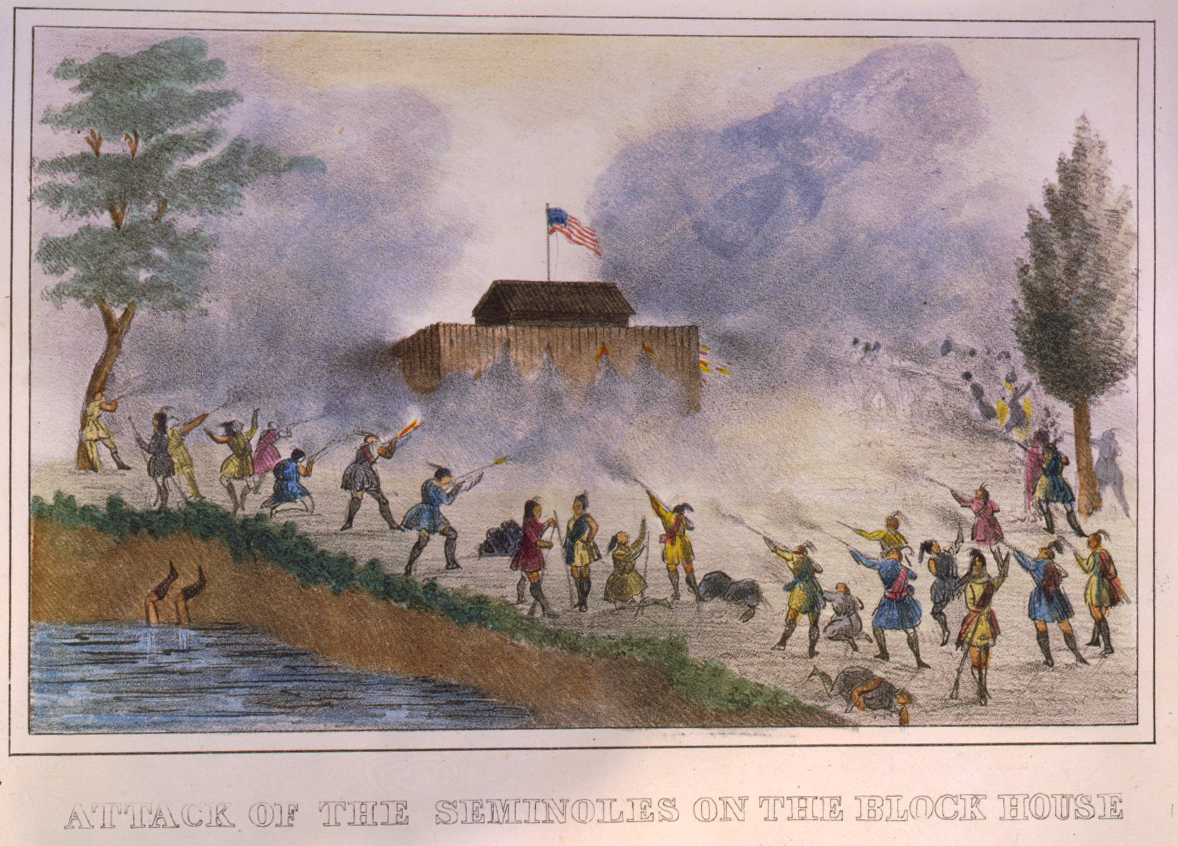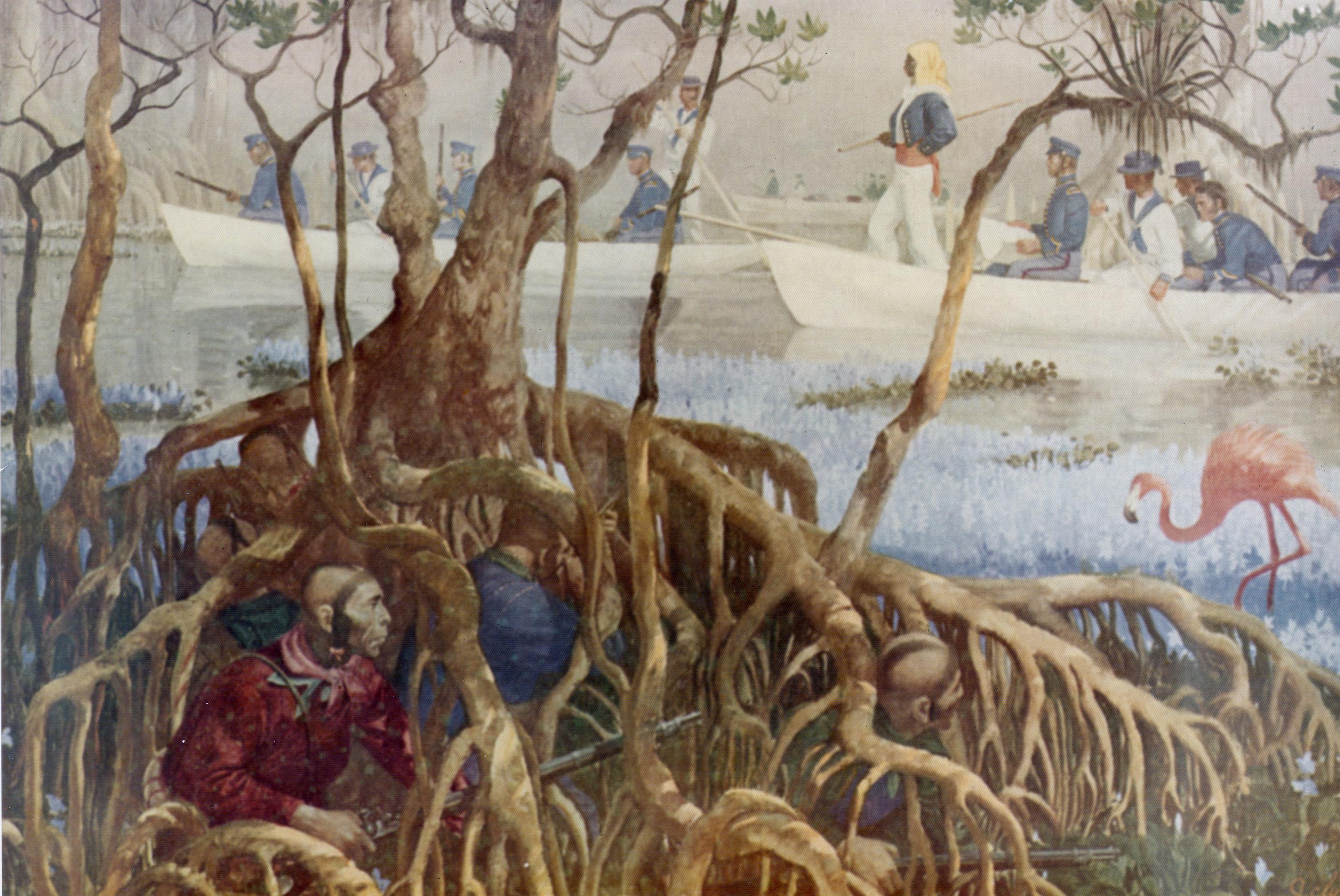|
Tustenuggee
''Tustenuggee'' ( in Muscogee) was a Muscogee title for the war leader of a tribal town. The ''tustenuggee'' was appointed by the ''micco'' (civil chief), and was responsible for leading the towns' warriors, advising the civil chief on matters relating to war, maintaining public order, and organizing stickball games with other towns. Most Seminole leaders from the period of the Seminole Wars are known by their war titles, which were always Muscogee in form, no matter what their primary language was. Tustenuggee has also become the surname of some descendants of Black Seminoles, probably from the association of an ancestor with a Seminole holding the title of ''tustenuggee''. Most of the following ''tustenuggees'' are known from the first half of the 19th century in Florida, primarily from the Second Seminole War: * Chitto Tustenuggee, known as "Snake Warrior" to whites. He was sent by Abiaka to negotiate with the U.S. Army in 1839, and reached an (ultimately unsuccessful) agreeme ... [...More Info...] [...Related Items...] OR: [Wikipedia] [Google] [Baidu] |
Second Seminole War
The Second Seminole War, also known as the Florida War, was a conflict from 1835 to 1842 in Florida between the United States and groups of people collectively known as Seminoles, consisting of Muscogee, Creek and Black Seminoles as well as other allied tribes (see below). It was part of a series of conflicts called the Seminole Wars. The Second Seminole War, often referred to as ''the'' Seminole War, is regarded as "the longest and most costly of the American Indian Wars, Indian conflicts of the United States". After the Treaty of Payne's Landing in 1832 that called for the Seminoles' removal from Florida, tensions rose until fierce hostilities occurred in Dade battle, Dade's massacre in 1835. This engagement officially started the war although there were a series of incidents leading up to the Dade battle. The Seminoles and the U.S. forces engaged in mostly small engagements for more than six years. By 1842, only a few hundred native peoples remained in Florida. Although no pea ... [...More Info...] [...Related Items...] OR: [Wikipedia] [Google] [Baidu] |
Halpatter Tustenuggee
Halpatter Tustenuggee (Alligator Warrior), also known as "Alligator" and "Chief Alligator" was born around 1795? in the Muscogee-Creek country of the current states of Alabama and Georgia; reportedly of Eufaula Creek lineage, he came to Spanish Florida following the Creek War in 1814. The town of Lake City, Florida, is associated with Halapatter Tustenuggee either because the original Native American settlement called "Halpatter Talofa" (also spelled "Alapata Telophka") which means "Alligator Town" in English, and was named after him or he was named after the aboriginal village. Tustenuggee was the title of the war chief of a tribal town of the Muscogee (Creek), Mikasuki, and Seminole people. Several of the leaders of those people during the Second Seminole War were commonly known by that title. Second Seminole War Halpatter Tustenuggee was around 40 years old when the Second Seminole War started; it is not clear if or where he participated in the First Seminole War although he ... [...More Info...] [...Related Items...] OR: [Wikipedia] [Google] [Baidu] |
Thlocklo Tustenuggee
Thlocklo Tustenuggee (also known as Thlocko, Thlocco, and Tiger Tail) was one of the most prominent Seminole leaders in the Second Seminole War. He spoke English fluently, and also spoke Muscogee. Tustenuggee was one of the three leaders of the 300 Seminoles who fought in the battle that became known as the Dade Massacre. During the war, he and Halleck Tustenuggee, another prominent Seminole leader in the war, met with General Walker Keith Armistead to negotiate, but negotiations broke down and the war resumed. As the war waned, Armistead used money to bribe several Seminole leaders to surrender, but Tustenuggee refused to be bribed and he continued to lead his band in fighting. When the war ended, his Seminole band was one of the few that remained in Florida Florida ( ; ) is a U.S. state, state in the Southeastern United States, Southeastern region of the United States. It borders the Gulf of Mexico to the west, Alabama to the northwest, Georgia (U.S. state), Georgia t ... [...More Info...] [...Related Items...] OR: [Wikipedia] [Google] [Baidu] |
Seminole Wars
The Seminole Wars (also known as the Florida Wars) were a series of three military conflicts between the United States and the Seminoles that took place in Florida between about 1816 and 1858. The Seminoles are a Native American nation which coalesced in northern Florida during the early 1700s, when the territory was still a Spanish colonial possession. Tensions grew between the Seminoles and American settlers in the newly independent United States in the early 1800s, mainly because enslaved people regularly fled from Georgia into Spanish Florida, prompting slaveowners to conduct slave raids across the border. A series of cross-border skirmishes escalated into the First Seminole War, when American general Andrew Jackson led an incursion into the territory over Spanish objections. Jackson's forces destroyed several Seminole, Mikasuki and Black Seminole towns, as well as captured Fort San Marcos and briefly occupied Pensacola before withdrawing in 1818. The U.S. and Spain soon ... [...More Info...] [...Related Items...] OR: [Wikipedia] [Google] [Baidu] |
Halleck Tustenuggee
Halleck Tustenuggee (also spelled Halek Tustenuggee and Hallock Tustenuggee) (c. 1807 – ?) was a 19th-century Mikasuki war chief. He fought against the United States government in the Second Seminole War and for the government in the American Civil War. Biography ''Tustenuggee'', translated as "Warrior" or "Grand Chief of War", was a Muskogean language title for the war leader of a tribal town. The ''tustenuggee'' was appointed by the ''micco'' (civil chief), and was responsible for leading the towns' warriors, advising the civil chief on matters relating to war, maintaining public order, and organizing stickball games with other towns. Halleck was born in central Florida as a Micosukee. He vehemently opposed the seizure of Indian lands by whites, and even killed his own sister by cutting her throat when she talked about surrender. He fought at the Battle of Lake Okeechobee on December 25, 1837, and took control of the Mikasuki force from their aged leader Abiaka (also kno ... [...More Info...] [...Related Items...] OR: [Wikipedia] [Google] [Baidu] |
Little Prince (chief)
Little Prince or Tastanaki Hopayi, Tustanagee Hopae (Tvstanagi Hopvyē in Mvskokē «Far Warrior» < ''ho·pv·yē'' «far») (died 1832) was an 18th-century chieftain and longtime representative of the Lower Creeks from the 1780s until his death in 1832. During the early 19th century, he and Big Warrior shared the leadership of the Creek National Council. Biography Little Prince is first recorded in 1780 living as a chieftain at Broken Arrow. During the summer, he joined British Indian Agent John Tate who led a combined fo ...[...More Info...] [...Related Items...] OR: [Wikipedia] [Google] [Baidu] |
Seminole
The Seminole are a Native American people who developed in Florida in the 18th century. Today, they live in Oklahoma and Florida, and comprise three federally recognized tribes: the Seminole Nation of Oklahoma, the Seminole Tribe of Florida, and the Miccosukee Tribe of Indians of Florida, as well as independent groups. The Seminole people emerged in a process of ethnogenesis from various Native American groups who settled in Spanish Florida beginning in the early 1700s, most significantly northern Muscogee Creeks from what are now Georgia and Alabama. Old crafts and traditions were revived in both Florida and Oklahoma in the mid-20th century as the Seminole began seeking revenue from tourists traveling along the new interstate highway system. In the 1970s, Seminole tribes began to run small bingo games on their reservations to raise revenue. They won court challenges to initiate Indian gaming on their sovereign land. Many U.S. tribes have likewise adopted this practice wh ... [...More Info...] [...Related Items...] OR: [Wikipedia] [Google] [Baidu] |
Abraham (Seminole)
Abraham, Seminole war-name Souanaffe Tustenukke, called Yobly by some whites, was a 19th-century Floridian who served as an interpreter and lieutenant for "Micanopy, the hereditary leader of the Alachua Seminoles." As of July 1837, he was termed "the principal negro chief" of the Seminoles and by all accounts exerted a great influence on Micanopy, approximately 500 Black Seminoles, and the white Americans with whom he treated and negotiated. Biography Abraham was born enslaved in Georgia in the 1790s and died in the 1870s in what is now Seminole County, Oklahoma. He was described as having ties to Pensacola, having traveled to Washington, D.C., and the Indian Territory, and having had "fluent speech and polished manners." He is sometimes described as Micanopy's "chief negro" in parallel with John Caesar, who was deemed "chief negro" to Ee-mat-la. Abraham, sometimes called Negro Abram, was a key participant in the 1837–38 negotiations regarding the end of hostilities in the S ... [...More Info...] [...Related Items...] OR: [Wikipedia] [Google] [Baidu] |
Mikasuki
The Miccosukee Tribe of Indians ( /ˌmɪkəˈsuki/, MIH-kə-SOO-kee) is a federally recognized Native American tribe in the U.S. state of Florida. Together with the Seminole Nation of Oklahoma and the Seminole Tribe of Florida, it is one of three federally recognized Seminole entities. They are Indigenous peoples of the Southeastern Woodlands. The Miccosukee, along with the Florida Seminole, speak the Mikasuki language, also spelled Miccosukee. The language has been referred to as a descendant of Hitchiti, a dialect of Hitchiti, and another term for Hitchiti.Hardy, Heather & Janine Scancarelli. (2005). Native Languages of the Southeastern United States'' Lincoln, NE: University of Nebraska Press, pp. 69-70 By the late 18th century, the British recorded the name Miccosukee, or Mikasuki, as designating a Hitchiti-speaking group centered on the town of Miccosukee, a tribal town affiliated with the Creek Confederacy. The town spanned sections of present-day Alabama, southe ... [...More Info...] [...Related Items...] OR: [Wikipedia] [Google] [Baidu] |
Oscen Tustenuggee
Oscen (died 1856) was the tustenuggee (war-chief) of a Muscogee village in southern Florida, and the most aggressive Seminole leader early in the Third Seminole War. Name Nineteenth-century sources used various spellings, including "Okchan", "Okchum", "Okchun", and "Oxian". "Tustenuggee" () is not a surname, but rather the Muscogee language, Muscogee word for the war-chief of a Tribal town#Governance, tribal town. Origin Oscen was a Miccosukee#18th and 19th centuries, Mikasuki who married a Muscogee woman and, as was customary in Mikasuki and Muscogee culture, lived in her village on Fisheating Creek west of Lake Okeechobee. One source says that village was led by Chipco, Echo Emathla Chipco, but a later source places Chipco's village of Tallahassees (a Muscogee band that lived near the site of Tallahassee, Florida, Tallahassee in the early 19th century) on the Kissimmee River, distinct from the village on Fisheating Creek where Oscen lived. Third Seminole War At the end of the Se ... [...More Info...] [...Related Items...] OR: [Wikipedia] [Google] [Baidu] |


